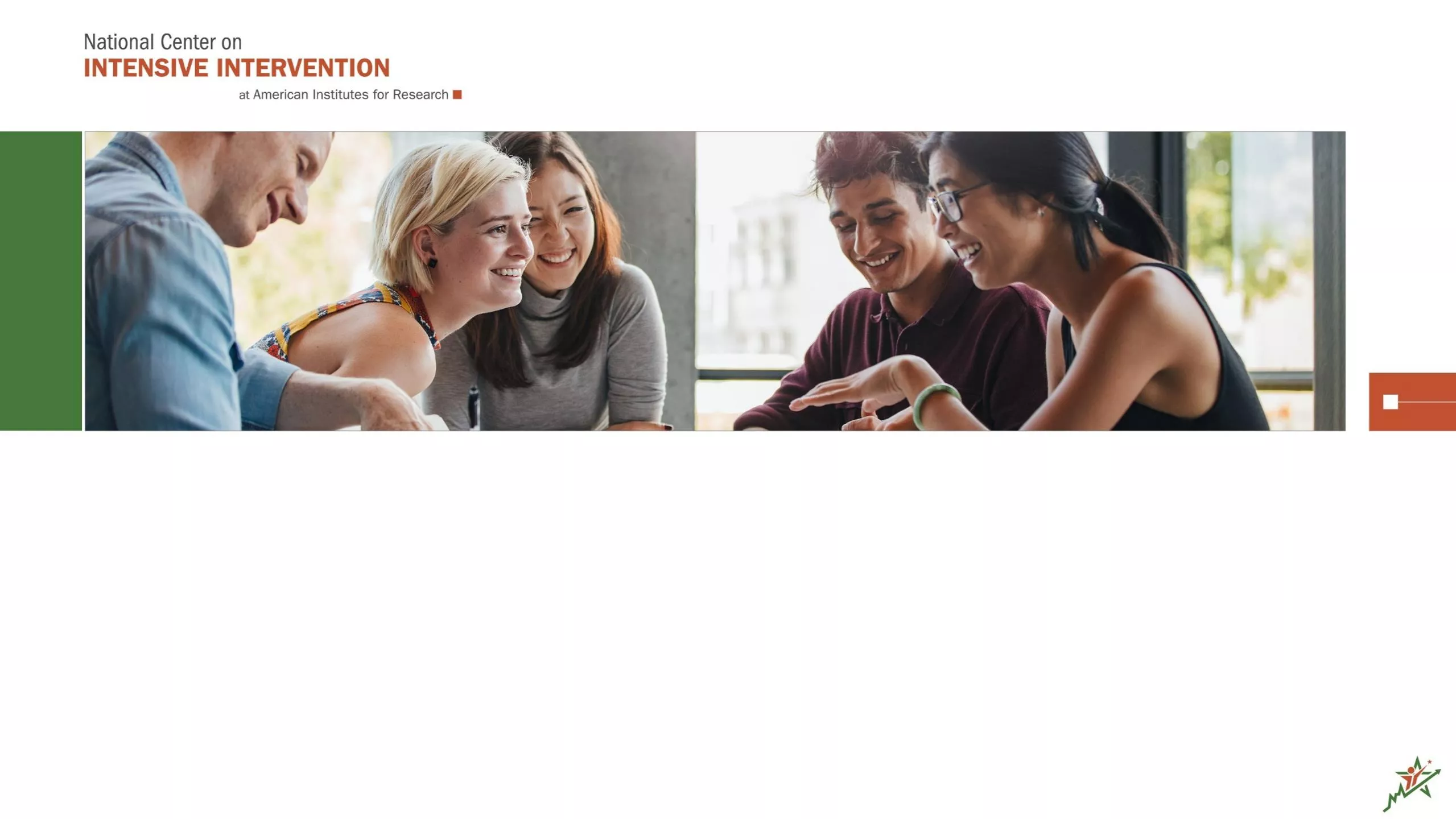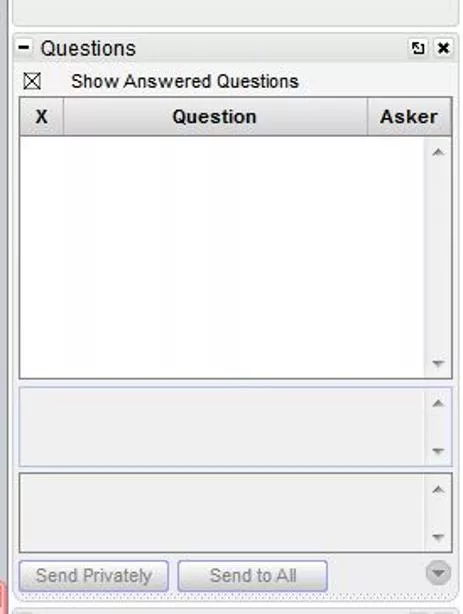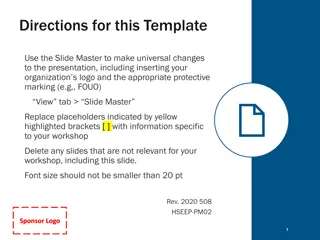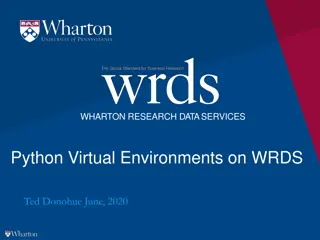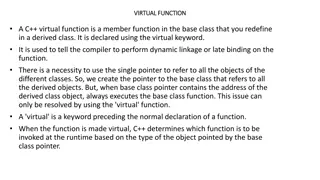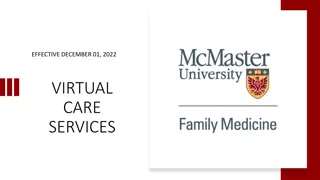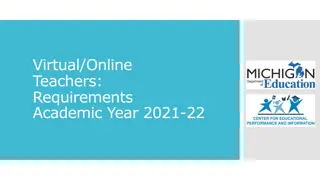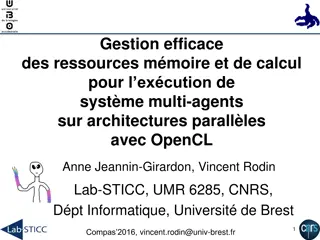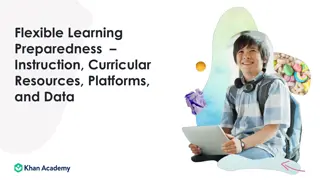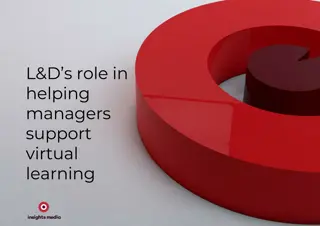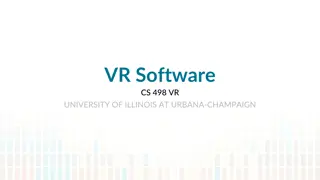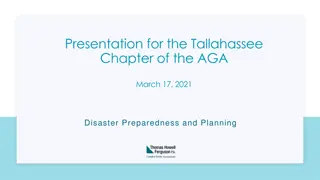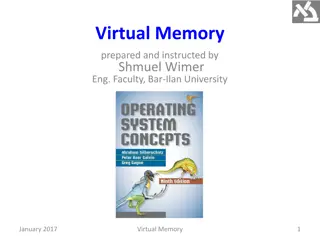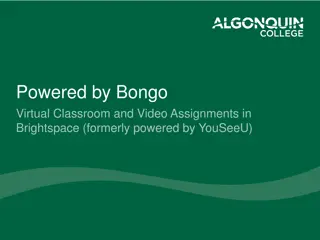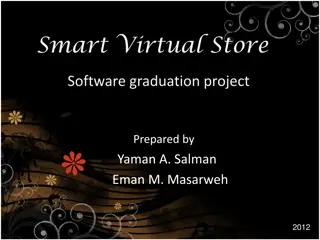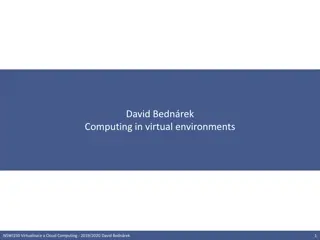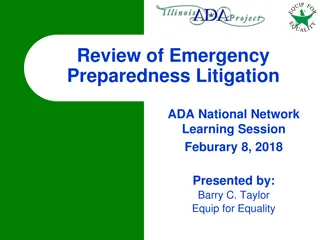Enhancing Teacher Preparedness for Virtual Learning Environments
This faculty professional learning series focuses on equipping educators with the necessary tools and resources to deliver effective interventions in virtual settings. Topics include strategies for online instruction, teacher expectations, and maintaining continuity of learning. The agenda covers considerations for intensive intervention, professional development strategies, and a Q&A session, providing valuable insights for teacher preparation. Shifts in teaching and learning infrastructure, such as access to technology and internet, are also highlighted.
Download Presentation

Please find below an Image/Link to download the presentation.
The content on the website is provided AS IS for your information and personal use only. It may not be sold, licensed, or shared on other websites without obtaining consent from the author. Download presentation by click this link. If you encounter any issues during the download, it is possible that the publisher has removed the file from their server.
E N D
Presentation Transcript
June 30, 2020 Preparing Teachers to Deliver Intervention in Virtual Settings Faculty Professional Learning Series: Webinar #1 Lindsey Hayes, M.Ed., & Amy Colpo, M.P.P., American Institutes for Research 1
Webinar Format & Questions Throughout the presentation, submit your questions into the question pod. For technical issues/questions, a webinar team member will try to assist you as soon as possible. For content related questions, there will be a time for Q&A at the end of the presentation. Submit your questions and we will share them with the presenters. 2
Faculty Professional Learning Series Teacher preparation faculty and professional development providers will: 1. Learn from colleagues and NCII experts about available tools and resources to enhance coursework, field experiences, and professional development opportunities related to intensive intervention. 2. Share successes, challenges, and lessons learned from the process of enhancing preservice and inservice learning opportunities for educators responsible for delivering intensive intervention. 3
Agenda Considerations for intensive intervention in virtual settings (15 min) Strategies for faculty and professional development providers (20 min) Q&A (15 min) Closing (10 min) 4
Teacher Expectations We need teachers who can: 1. Manage rapid transitions to online, virtual, and/or distance instruction. 2. Plan for blended or hybrid instructional models. 3. Maintain continuity of learning for our most vulnerable learners. How do we adjust preparation and professional learning experiences to prepare teachers for what lies ahead? 6
Continuity of Learning The U.S. Office of Special Education Programs (OSEP) has a website with resources to address continuity of learning during COVID-19. Topical issue briefs Parents and families Teachers Related service providers Webinars Resource database 7
Shifts in Teaching and Learning Infrastructure- Level Access Student-Level Access Hardware (e.g., computer, laptop, other devices) Software (e.g., learning management systems, videoconferencing) High-speed internet and/or Wi-Fi Mobile device compatibility Cognitive and executive functioning (e.g., processing, reasoning, working memory) Physical or sensory concerns (e.g., visual, hearing, mobility) Reading ability Ability to use assistive technologies Source: U.S. Department of Education Office of Special Education Programs, 2020. 8
Shifts in Intensive Intervention Delivery Shifts in the Virtual Setting: Delivering Tier 2 with fidelity Implementing progress monitoring procedures Individualizing and intensifying interventions Blending academic and behavioral supports Collecting and using data 9
Strategy #1 Model using explicit instruction to intensify delivery of virtual instruction. 10
Explicit Instruction Is A way of teaching where the teacher: Selects an important objective Specifies the learning outcome Designs structured instructional experiences Explains directly Models the skill being taught Provides scaffolded practice to achieve mastery Instructional modalities change. Technologies change. The principles of explicit instruction remain the same. Source: Kearns, 2018. 11
Example: Lesson Opening Lesson Opening Identify learning objective Review prior knowledge and skills Delivery of Instruction Model step-by-step ( I do ) Group practice ( We do ) Individual practice ( You do ) Lesson Conclusion Review critical content Assign independent practice Monitor and assess progress Design Questions: How will I ensure students know their learning objective? How will I activate my students interests and prior knowledge? Strategies For the Virtual Setting: Students complete an online quiz as a do-now activity as they enter the virtual classroom. Teacher monitors responses and re-teaches as necessary. Teacher screen shares the lesson objective. Students paraphrase the objective in their own words in the chat pod. 12
Example: Delivery of Instruction Lesson Opening Identify learning objective Review prior knowledge and skills Delivery of Instruction Model step-by-step ( I do ) Group practice ( We do ) Individual practice ( You do ) Lesson Conclusion Review critical content Assign independent practice Monitor and assess progress Design Questions: How will I present the material? How will I gradually release responsibility for the task? How will I provide frequent and varied opportunities for student response? How will I give specific and timely feedback? Strategies For the Virtual Setting: Teacher models the skill by drawing on the whiteboard while conducting a think-aloud. Students respond to checks for understanding using polls, annotation features, and thumbs-up signals. Teacher assigns heterogenous groups to breakout rooms during practice time and rotates among them. Teacher gives feedback to individual students via the chat pod. 13
Example: Lesson Conclusion Lesson Opening Identify learning objective Review prior knowledge and skills Delivery of Instruction Model step-by-step ( I do ) Group practice ( We do ) Individual practice ( You do ) Lesson Conclusion Review critical content Assign independent practice Monitor and assess progress Design Questions: How will I provide opportunities for students to demonstrate independent mastery of the task? How will I assess and give feedback on student performance? Strategies For the Virtual Setting: Students take turns as presenter to share their work to the class. Teacher assigns an online quiz for an exit ticket and follows up with individual students as necessary. Students submit videos of their work, including think-alouds, for teacher feedback. 14
Example: Behavior Teach and model expectations for virtual PBIS Behavior Teaching Matrix for Remote Instruction PBIS Behavior Teaching Matrix for Remote Instruction instruction: PBIS Behavior Teaching Matrix for Remote Instruction Class procedures Technology norms Asking for help Provide prompts, reminders, guides, rubrics, and checklists that focus on: Self-regulation skills Increasing length of on-task behaviors Source: Center on Positive Behavioral Interventions & Supports, 2020. 15
Sample Lessons LITERACY MATHEMATICS BEHAVIOR 16
Intensive Intervention Course Content Ready-to-use content for faculty and professional development providers! Features of Explicit Instruction Intensive Intervention in Mathematics Intensive Intervention in Reading Behavior Support for Intensive Intervention 17
Strategy #2 Blend synchronous and asynchronous learning supports. 18
Instructional Modalities Synchronous instruction: Learning activities occur in real time Teleconferencing Virtual class sessions Live-streamed lectures Traditional classroom instruction Asynchronous instruction: Learning activities occur independently of time Discussion boards Self-paced modules Recorded videos or lectures 19
Blended Supports for Intensive Intervention Intensification Practice Categories 1. Change intervention dosage or time Synchronous Asynchronous Virtual features to increase response opportunities (e.g., polling, annotation) Shorter and more frequent sessions Access to recorded intervention sessions Supports for parents and families to practice with their student 2. Change learning environment to promote attention and engagement 3. Combine cognitive processing strategies with academic learning Small group or individual breakout groups Visual cues to remain on-task Virtual class resource space Multimedia resources and activities Virtual note-taking templates and graphic organizers Self-regulation and self-monitoring supports Explicit, systematic instruction with visual and auditory aids Virtual features to increase feedback opportunities (e.g., chat pod, breakouts) Support with offline organization skills Self-regulation and self-monitoring supports 4. Modify delivery of instruction Structured independent practice opportunities with feedback (e.g., submission of video, online quiz, etc.) 20
Planning Considerations Student level Age and/or grade Self-regulation abilities Availability of family support Group level Universal Design for Learning Positive Behavioral Interventions & Supports Source: CAST, 2018. 21
Strategy #3 Plan for adjusting progress monitoring and data collection procedures. 22
Virtual Progress Monitoring Teachers and administrators need to plan for how they will collect and analyze progress monitoring data in a virtual setting. This collection of Frequently Asked Questions on Collecting Progress Monitoring Data Virtually is intended to provide a starting place for consideration. 23
Tools Chart Updates Academic Screening Tools Chart Behavioral Screening Tools Chart Academic Intervention Tools Chart Behavioral Intervention Tools Chart Academic Progress Monitoring Tools Chart Behavioral Progress Monitoring Tools Chart 24
Strategy #4 Create additional opportunities for observation and feedback. 25
Video As a Teaching and Reflection Tool Video observation and analysis can: Provide teachers with examples of high-quality, effective instruction. Increase the frequency of practice and feedback opportunities. Allow teachers to reflect on and improve their own instruction. 26
NEW! Virtual Lesson Implementation Virtual Implementation of Reading Lesson: Educator Example Sample Lessons: Literacy Strategies to Support Intensifying Interventions Sample Lessons to Support Continuity of Learning During COVID-19: Tips for Educators 27
Strategy #5 Promote collaboration with team members. 28
Virtual Collaborators Parents and families How do we prepare teachers to collaborate with team members for intensive intervention in virtual settings? General education teachers Paraprofessionals Related service providers 29
NEW! Parent Video Examples Using Sample Lessons to Support Continuity of Learning During COVID-19: Tips for Parents 30
NEW! Parent Tip Sheets Using Sample Lessons to Support Continuity of Learning During COVID-19: Tips for Parents 31
IEP Meeting Resources PROGRESS Center: Virtual IEP Meeting Tip Sheets Virtual IEP Meeting Sample Agenda NCII: Tools to Support Intensive Intervention Data Meetings 32
Questions? 33
Final Considerations Explore opportunities for action research. Consider creating video examples of virtual instruction. Share resources with colleagues. Stay tuned for further NCII resources! 34
NCII Community of Practice (CoP) Learn from NCII experts about available tools and resources with application for distance/virtual learning. Pilot the use of tools and resources. Share lessons learned with other educators. Refine implementation. Support NCII with developing products focused on delivering distance/virtual intensive intervention. 35
CoP Final (Draft!) Product Example #1 Virtual screening and progress monitoring delivery 36
CoP Final (Draft!) Product Example #2 Using mathematics manipulatives virtually 37
CoP Final (Draft!) Product Example #3 Supporting parents with collecting data on IEP goals 38
Upcoming Webinars Webinar #2: Practice-Based Opportunities for Intensive Intervention August 6, 2020 from 3:00-4:00pm ET Webinar #3: Course Content Resources for Intensive Intervention October 7, 2020 from 3:00-4:00pm ET Webinar #4: Continuous Program Improvement December 1, 2020 from 3:00-4:00pm ET 39
www.intensiveintervention.org Lindsey Hayes: lhayes@air.org Amy Colpo: acolpo@air.org ncii@air.org https://twitter.com/TheNCII https://www.youtube.com/channel/UC6W2pma8TiSZvY_GWROkTLA 1000 Thomas Jefferson St., NW | Washington, DC 20007-3835 | 866.577.5787 40
References CAST (2018). Universal Design for Learning guidelines version 2.2. Retrieved from http://udlguidelines.cast.org Center on Positive Behavioral Interventions & Supports. (2020, March 27). Creating a PBIS behavior teaching matrix for remote instruction. Retrieved from https://www.pbis.org/resource/creating-a-pbis-behavior- teaching-matrix-for-remote-instruction Kearns, D. (2018). Intensive intervention course content: Features of explicit instruction. Retrieved from https://intensiveintervention.org/intensive-intervention-features-explicit-instruction U.S. Department of Education, Office of Special Education Programs. (2020). Evidence-based and promising practices to support continuity of learning for students with disabilities: Practices and resources to support teachers. Retrieved from https://osepideasthatwork.org/sites/default/files/SWDLearning-Teachers-508.pdf 41
NCII Disclaimer This presentation was produced under the U.S. Department of Education, Office of Special Education Programs, Award No. H326Q160001. Celia Rosenquist serves as the project officer. The views expressed herein do not necessarily represent the positions or policies of the U.S. Department of Education. No official endorsement by the U.S. Department of Education of any product, commodity, service, or enterprise mentioned in this presentation is intended or should be inferred 42
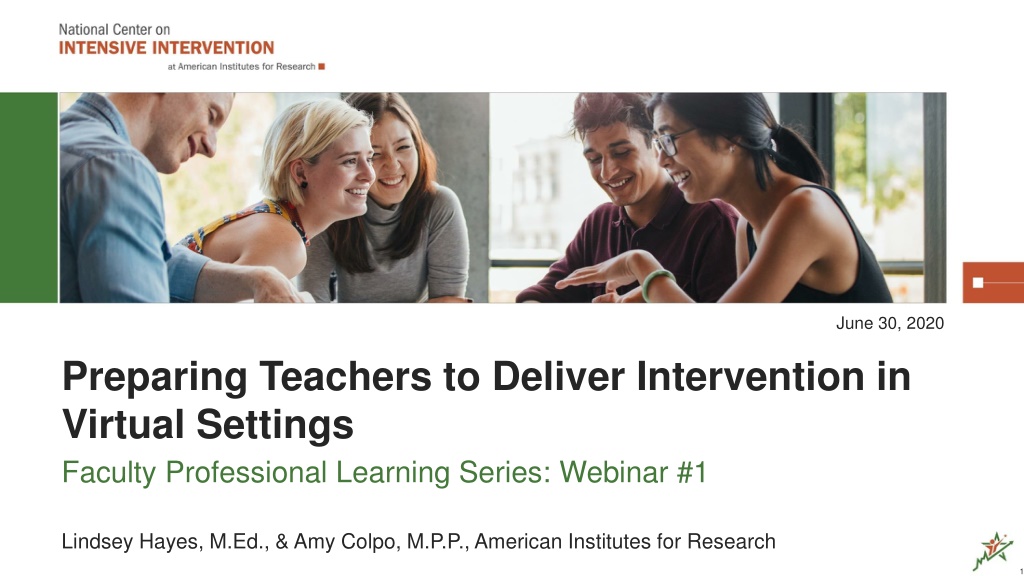
 undefined
undefined